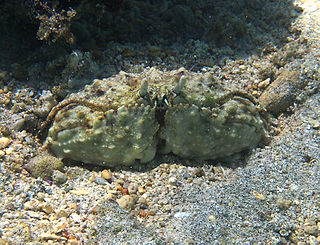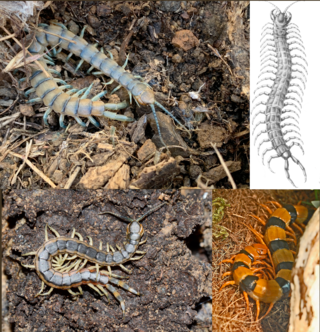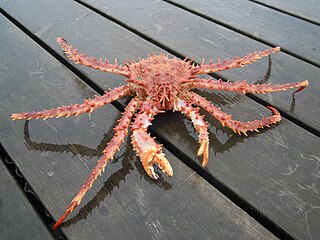
The Decapoda or decapods are an order of crustaceans within the class Malacostraca, and includes crabs, lobsters, crayfish, shrimp, and prawns. Most decapods are scavengers. The order is estimated to contain nearly 15,000 extant species in around 2,700 genera, with around 3,300 fossil species. Nearly half of these species are crabs, with the shrimp and Anomura including hermit crabs, porcelain crabs, squat lobsters making up the bulk of the remainder. The earliest fossils of the group date to the Devonian.

King crabs are decapod crustaceans in the family Lithodidae that are chiefly found in deep waters. King crabs are not true crabs and are generally thought to be derived from hermit crab ancestors within the Paguridae, which may explain the asymmetry still found in the adult forms. This ancestry is supported by several anatomical peculiarities which are present only in king crabs and hermit crabs. Although some doubt still exists about this hypothesis, king crabs are the most widely quoted example of carcinisation among the Decapoda. Several species of king crabs, especially in Alaskan and southern South American waters, are targeted by commercial fisheries and have been subject to overfishing.

Cancer is a genus of marine crabs in the family Cancridae. It includes eight extant species and three extinct species, including familiar crabs of the littoral zone, such as the European edible crab, the Jonah crab and the red rock crab. It is thought to have evolved from related genera in the Pacific Ocean in the Miocene.

Calappa is a genus of crabs known commonly as box crabs or shame-faced crabs. The name box crab comes from their distinctly bulky carapace, and the name shame-faced is from anthropomorphising the way the crab's chelae (claws) fold up and cover its face, as if it were hiding its face in shame.

Charybdis is a genus of swimming crabs in the family Portunidae. It is named after the monster Charybdis of Greek mythology.

Cancridae is a family of crabs. It comprises six extant genera, and ten exclusively fossil genera, in two subfamilies:

Scolopendra is a species-rich genus of large tropical centipedes of the family Scolopendridae.

Lithodes maja, the Norway king crab or northern stone crab, is a species of king crab which occurs in colder North Atlantic waters off Europe and North America. It is found along the entire coast of Norway, including Svalbard, ranging south into the North Sea and Kattegat, the northern half of the British Isles, and around the Faroe Islands, Iceland, and off south-eastern Greenland. In the West Atlantic, it ranges from the Davis Strait between Greenland and Canada south to The Carolinas in the United States.

Hippoidea is a superfamily of decapod crustaceans known as mole crabs or sand crabs.

Potamonautidae is a family of freshwater crabs endemic to Africa, including the islands of Madagascar, the Seychelles, Zanzibar, Mafia, Pemba, Bioko, São Tomé, Príncipe and Sherbro Island. It comprises 18 extant genera and 138 extant species. Fossil remains dating from the Late Miocene period have been attributed to the family Potamonautidae.

Liocarcinus depurator, sometimes called the harbour crab or sandy swimming crab, is a species of crab found in the North Sea, Atlantic Ocean, Mediterranean Sea, and Black Sea. It grows up to 50 millimetres (2.0 in) in width and 40 mm (1.6 in) long, and can be distinguished from other crabs, such as the shore crab Carcinus maenas, by the curved rows of white spots on its carapace.

Albuneidae is a little-known family of specialized burrowing sand crabs. There are 50 extant species as well as nine fossil species that have been described. Fossil specimens have been described from the Cretaceous, Miocene and Oligocene.

Dromia personata, also known as the sponge crab or sleepy crab, is a species of crab found in the North Sea, the Mediterranean Sea, and connecting parts of the northeastern Atlantic Ocean. Like most other epibenthic crustaceans, the biomass of this species is especially dense in the Mediterranean continental shelf. It mainly resides from the lower shore to a depth of 50 meters (164 ft), often in caves. Occasionally, they are found living in depths as low as 110 meters (360 ft). They serve as prey for octopus, starfish, and other fish. Their last two pairs of legs are positioned dorsally, and are used to hold a sponge in place as camouflage.

Percnon gibbesi is a species of crab. It is one of at least two species commonly called Sally Lightfoot, and is also referred to as the nimble spray crab or urchin crab. It has been described as "the most invasive decapod species to enter the Mediterranean".
In the 10th edition of Systema Naturae, Carl Linnaeus classified the arthropods, including insects, arachnids and crustaceans, among his class "Insecta". Wingless arthropods were brought together under the name Aptera.

Gelasimus vocans is a species of fiddler crab. It is found across the Indo-Pacific from the Red Sea, Zanzibar and Madagascar to Indonesia and the central Pacific Ocean. It lives in burrows up to 50 centimetres (20 in) deep. Several forms of G. vocans have been recognised, with their authors often granting them the taxonomic rank of full species or subspecies.

Blepharipodidae is a family of sand crabs (Hippoidea), comprising the two genera Blepharipoda and Lophomastix. They are distinguished from the other families in the superfamily Hippoidea by the form of the gills, which are trichobranchiate (filamentous) in Blepharipodidae, but phyllobranchiate (lamellar) in Albuneidae and Hippidae. Fossils belonging to the genus Lophomastix have been found in rocks dating back to the Eocene.

Albunea carabus is a rare species of "sand crab" or "mole crab" in the family Albuneidae. It lives in shallow, turbulent waters in sandy areas of the tropical eastern Atlantic Ocean and the Mediterranean Sea.
Brachynotus sexdentatus is a species of crab in the family Varunidae. It is native to the Mediterranean Sea and Black Sea, and became established for a time in Swansea Docks. It grows to a maximum carapace width of 18 mm (0.71 in), and lives in shallow water on muddy bottoms.

Calappa calappa, also known as the smooth box crab or red-spotted box crab, is a tropical marine species of crab with an Indo-Pacific distribution, and showing great variability in its patterning and colouration. First described as Cancer calappa by Linnaeus in 1758 from a specimen originating from Ambon Island, and later in 1781 as Cancer fornicatus by Fabricius, it was finally placed in the genus Calappa by Lancelot Alexander Borradaile in 1903. The name calappa is associated with kelapa, the Malay word for 'coconut'.

















